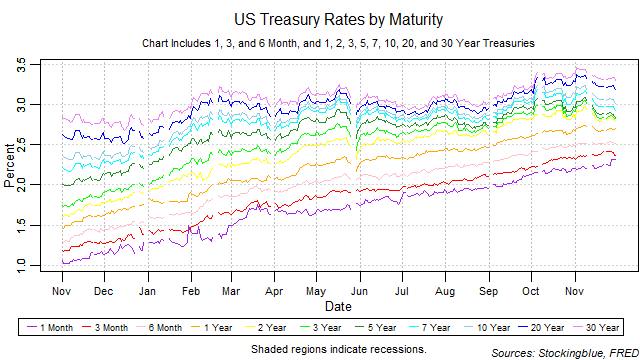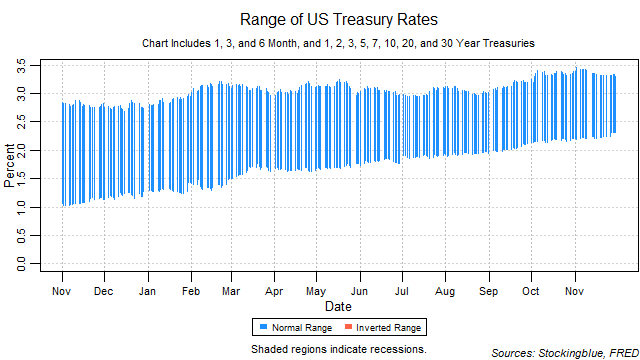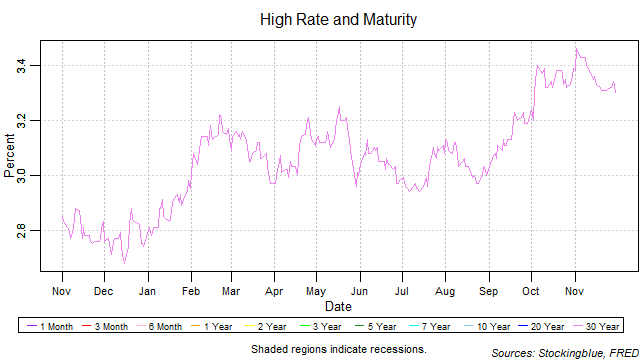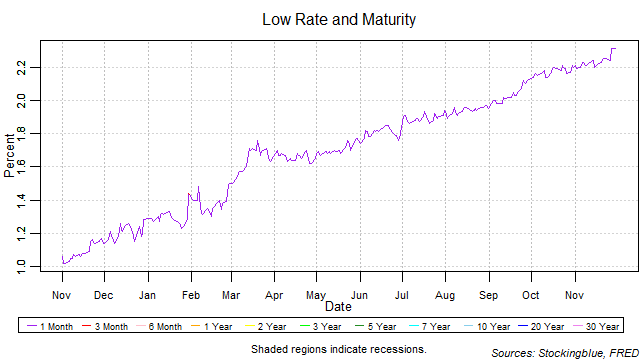
The one, three, and six-month, and the one-year rates rose in November while all other rates dropped. The yield curve narrowed from the previous month thus ending its one month widening streak. The one-month bill maintained the lowest rate throughout the month. Long-term rates fell while short-term rates rose thus increasing the risk of an inversion brought upon by rising short-term rates. Such an inversion, if it were to happen would be a strong indicator for an upcoming recession.
Findings
- The one, three, and six-month, and the one-year rates rose in November. All other rates dropped.
- The one-month rate saw the largest absolute growth at 0.11 points.
- On a relative basis, the one-month rate grew the most with a 5.00 percent rise.
- The seven-year rate saw the largest absolute drop at 0.15 points.
- On a relative basis, the seven-year rate dropped the most with a 4.89 percent drop.
- The one-month bill maintained the lowest rate throughout the month.
- The yield curve narrowed from 1.19 to 0.99.
Caveats
- As always, past performance is not indicative of future results.
- The rates have been at historic lows for quite some time which has not occurred previously.
- All figures are rounded to the nearest hundredth.
Details

The breadth of the yield curve narrowed over the month from a range of 1.19 to a range of 0.99. The widest range was 1.27 (0.02 points higher than the previous month's widest range of 1.25) which was hit on November 2 and the narrowest 0.99 (0.07 points lower than the previous month's narrowest range of 1.06) which was hit on November 30, the last trading day of the month. The last time the yield curve was this narrow was on November 6, 2007 when it hit a range of 0.96.

The thirty-year bond held the highest rate throughout the month. It rose sharply in the first trading days of the month only to drop steadily for the remainder of the month. It has remained above 3 percent for the entire duration of the month. It should be noted that the ten and 20-year rates were at or above 3 percent on all trading days of the month. In addition, the seven-year rate spent half the month at or above 3 percent and the three and five-year rates had several sessions above three percent. The last time the 30-year rate hit this month's high of 3.46 was on July 3, 2014 when it was at 3.47. The last time the three-year rate was at or above 3 percent prior to this month was on July 25, 2008.

The one-month note held the lowest rate for every session of the month. However, it has hit a new 12-month high for the seventh time in seven months and has not been as high as 2.31 (its high for the month) since February 26, 2008 when it was at 2.34.
Sources
"Treasury Constant Maturity," Federal Reserve Bank of St. Louis, accessed December 3, 2018, https://fred.stlouisfed.org/categories/115.